Where we last saw the corset, I had put prussian tape on all of the seams and satin stitched the edges.

Next is drawing in the guides for the bones. The bones will wind up following the curve of the body.

Pin the bone casing along the bone guides drawn in chalk.
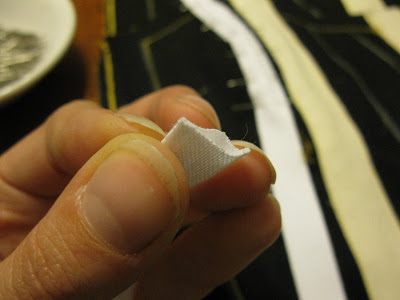
Bone casing is a little neatly made tube -- perfect for boning to slide through. Note how there is a little bit stitched together on either side. That's where you stitch.

Stitch, and press!

Attach all of the bone casing in a similar manner.

Here's a lovely little coil of spiral steel boning.

A cute little pile of bone tips. Do you see where this is going?
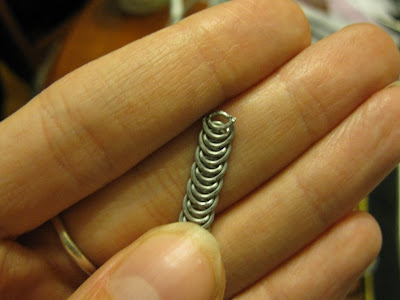
You're going to want to cut the boning to the length that you want, and snip pointy bits off so that it's vaguely rounded.
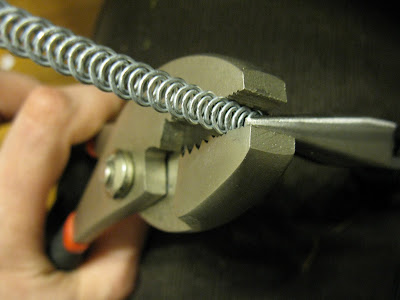
Using two pairs of pliers, you'll want to crimp the bone tip over the edge of the bone. If you can manage this with one pair of pliers, you're a magician. And yes, I took that picture myself. :-P

Double check to make sure that the bone is the right length -- too long and you'll have problems, too short and it'll wiggle.

Slide the boning into the bone casing. Make sure that it's actually in the channel, and not between the coutil and the casing -- an easy mistake to make.

Stitch along the "stitch outline" (where you've already stitched along the coutil where you want the edge of your corset to be) to keep the boning in it's little case. Please be extra care to NOT stitch on the bone, as that's a sure-fire way to snap a needle. Ask me how I know.

Now would be a good time to cut, file to rounded edges and cover with nail polish (or tip dip) any spring steel that you're using.
A quick note about the different steel boning: spiral steel is like a spring that's been laid flat. Because it's a spiral, it'll bend side to side -- which is why it's excellent for curving along the body. But where it fails in corsetry is where you require rigidity: along the grommets and your opening (either busk or hooks). I'm using spring steel for along the grommets. It's thin, and flexes along it's length (so can follow your spine) but does not bend side to side (so tight lacing will not warp the shape of your corset). A busk is the traditional opening for corsets: it's like a wide spring steel with hooks and eyes attached to it. I do not have extra busks lying around, so I've opted for another method which I'll explain.
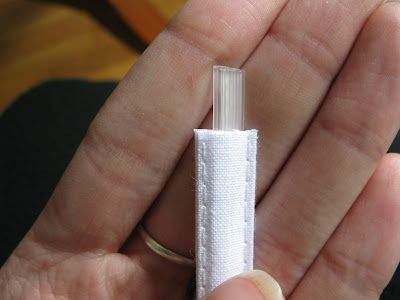
This is plastic boning. It comes in it's own bone casing, and you can buy it by the yard in most fabric stores (at least in the US). (The steel bones I order online.)
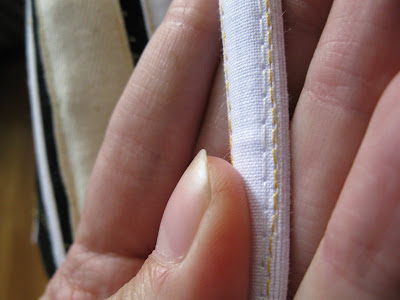
You're going to want to stitch two lengths of it together -- again being careful not to stitch on the bone.

You're then going to attach this doubled bone along the line where your corset closes in the front. If I had more spring steel, I might have used that here. Now comes the fun part -- putting in the hook and eyes!

Here are the hook and eyes that I will be using. Note that they are already attached to a tape, premeasured so that I don't have to do any math to make them match up. Yay for less math!

My cast of characters: dressmaker's awl, oboe-reed-maker's mandrel (not everyone has this one... :-P), and my little snips.
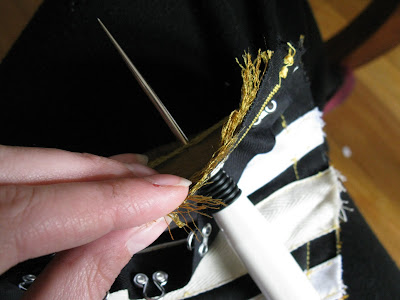
I start the hole for where I want either my hook or eye with the awl. The reason why we're doing it this way is to cut fewer threads and keep the fabric stronger.

It's not big enough, so I use the mandrel to make the hole bigger. If I was putting the hooks in, I'd stop here.

For the eyes I needed a slightly bigger hole, and used my snips.

A couple of eyes poking through!

Before the eyes even start to think about breaking for freedom, you're going to want to stitch them in tight. Because you'll be sewing over bones, handsewing is really the only way to go. I'm just doing a simple whip stitch, but you can feel free to be fancy.

All of the eyes installed.

All of the hooks and eyes are now poked through and stitched in place.

Now would be a good time to pretend that you've been working on the lining this whole time.

You'll want prussian tape along all of the seams here as well. This is a good time to check that all of the boning is in your corset and secure -- don't forget the spring steel that had to dry!

Stitch the lining and the corset together. right sides facing, along the top and the side where the grommets will go -- leave two sides unstitched (but fold the lining fabric to where it'll need to be along the hook and eyes). Again, be careful of the bones.

Bring the satin stitched side in a little, so that the satin stitch is a mere 1/4" from the bone.

Trim the seam between the corset and the lining down to 1/4" all around (coming as close to the satin stitch as you dare). If you can trust your fabric to go closer than 1/4" go for it!

Turn right-side out and press well. It'll want to fight you, because the lining doesn't have nearly the weight of the corset. But convince it.
All that remains now is handstitching along the remaining two edges and installing grommets! And then you'll be done.







